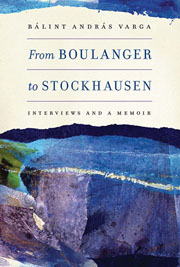Book contents
- Frontmatter
- Dedication
- Contents
- Foreword
- Acknowledgments
- Part One Interviews
- Preface to the Interviews
- Composers
- Conductors
- Instrumentalists
- Singers and a Record Producer
- A Teacher
- Music Administrators
- Snippets
- Claudio Abbado
- Sir Neville Cardus
- Aaron Copland
- Antal Doráti
- Géza Frid
- Sylvia Goldstein
- Ralph Kirkpatrick
- Witold Lutosławski
- Vlado Perlemuter
- Arthur Rubinstein
- György Sándor
- Walter Susskind
- Joseph Szigeti
- Part Two A Memoir
- Notes in Retrospect
- Index
- Miscellaneous Endmatter
György Sándor
from Snippets
Published online by Cambridge University Press: 05 January 2014
- Frontmatter
- Dedication
- Contents
- Foreword
- Acknowledgments
- Part One Interviews
- Preface to the Interviews
- Composers
- Conductors
- Instrumentalists
- Singers and a Record Producer
- A Teacher
- Music Administrators
- Snippets
- Claudio Abbado
- Sir Neville Cardus
- Aaron Copland
- Antal Doráti
- Géza Frid
- Sylvia Goldstein
- Ralph Kirkpatrick
- Witold Lutosławski
- Vlado Perlemuter
- Arthur Rubinstein
- György Sándor
- Walter Susskind
- Joseph Szigeti
- Part Two A Memoir
- Notes in Retrospect
- Index
- Miscellaneous Endmatter
Summary
The Hungarian pianist György Sándor was a pupil of Béla Bartók at the Budapest Academy of Music. They grew close after the composer's emigration to the United States, where Sándor himself had settled in 1939.
Beyond recording an interview with him in 1971 in Budapest, we spent some time together privately. He struck me as a man of the world of the old school: he wore his wavy hair rather long combed back; he was always impeccably dressed, with a silk necktie and a matching kerchief in his breast-pocket. He was a superb causeur; I could listen to his anecdotes for hours.
Sándor was also a serious musician. I attended his course at the International Bartók Seminar in Budapest and was fascinated by his analysis of From the Island of Bali from Mikrokosmos. He illuminated its details with the exactitude of an X-ray and also gave his students an idea of the process of creation. Individual tones and chords were lifted out of their context, examined from different angles, and then replaced in the fabric of the music.
György Sándor premiered Bartók's Piano Concerto no. 3 on February 8, 1946, in Philadelphia, with Eugene Ormandy conducting. That alone secures him a place in music history. He also recorded all the piano works of Bartók, Kodály, and Prokofiev; all three releases were highly regarded.
I asked him if Bartók talked to him about his compositions.
- Type
- Chapter
- Information
- From Boulanger to StockhausenInterviews and a Memoir, pp. 257 - 259Publisher: Boydell & BrewerPrint publication year: 2013



